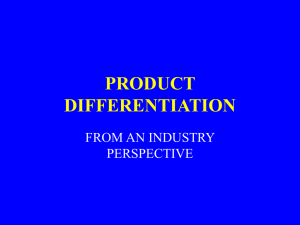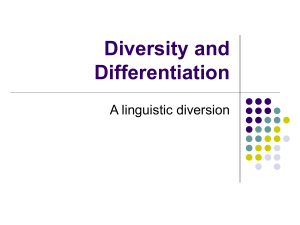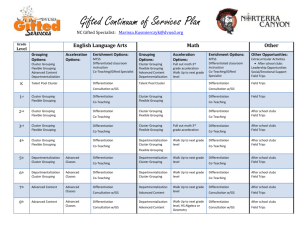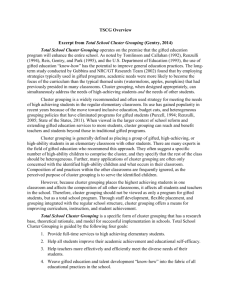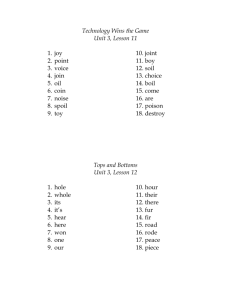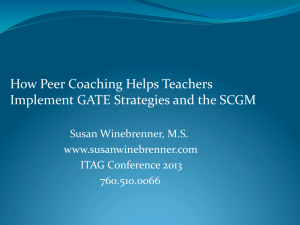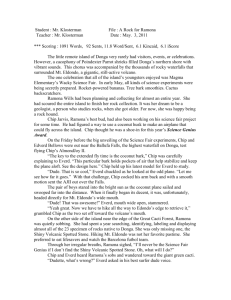readingstrategiesfor5th quintile
advertisement
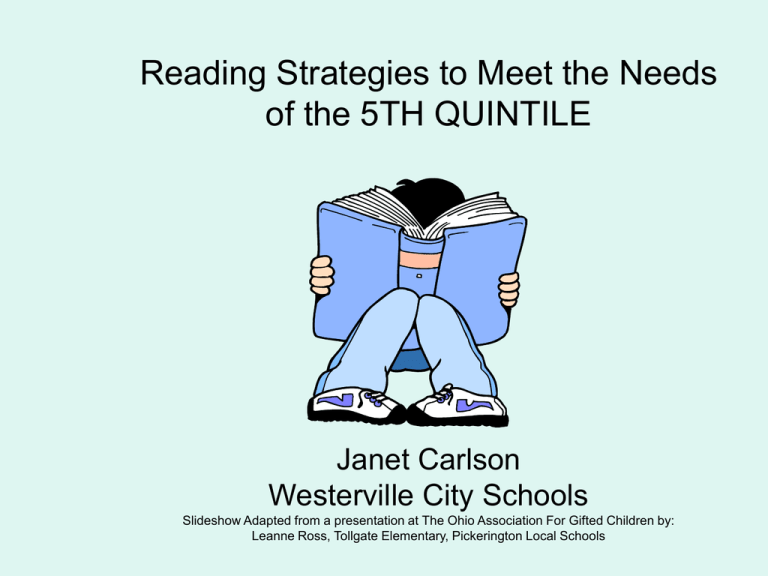
Reading Strategies to Meet the Needs of the 5TH QUINTILE Janet Carlson Westerville City Schools Slideshow Adapted from a presentation at The Ohio Association For Gifted Children by: Leanne Ross, Tollgate Elementary, Pickerington Local Schools Essential Questions • What can be done to ensure challenge for our 5th quintile students? • What strategies are available to meet the educational needs of these students? • Are we willing to become flexible enough to use these strategies? • Is it worth our time? Strategies known to help 5th quintile students grow and learn • Flexible cluster grouping • Enriched grade level content standards • Focus on higher level interpretations and communication • Differentiation • Formative assessment for appropriate and clear learning targets • Opportunities for authentic work • Acceleration Flexible Cluster Grouping A study examined the use of cluster grouping in two elementary graduation classes (n=197). During the three program years, students involved in the school using cluster grouping were more likely to be identified as high achieving or above average, and all students had significant increases in achievement test scores. Gifted Child Quarterly, v52 n3 p183-198 2008 Marcia Gentry Characteristics of flexible cluster grouping 1. All students are initially placed in an ability based cluster group using testing data. 2. Professional development is provided for teachers based upon the group level with which they are working 3. Students are constantly reassessed based on achievement and moved between groups as needed. Flexible cluster grouping Advantages Obstacles to overcome • Students receive instruction related to their own specific needs. • Teachers are better able to direct their planning to one or two subsets of students rather than five or six. • Student placement is fluid. • Scheduling – the same subject must be taught at the same time in multiple classrooms. • Teacher control of “her students” – teachers start to share students and are not able to be self contained. Defining Enrichment • “Activities that add or go beyond the existing curriculum. Activities may occur in the classroom or in a separate setting” • “Deeper coverage of content often provided for gifted students.” • Horizontal curriculum expansion.” • “Extension of the regular curriculum to include higher level thinking skills and more advanced knowledge acquisition related to the content” Enriching Content Standards How to Enrich • Teach students grade level standards with extensions and more in depth activities. • Replace skill acquisition lessons with higher level thinking activities. • Have high level students work collaboratively on group projects. • • • • How Not to Enrich Teaching above grade level standards. Giving students packets of “extra” materials to cover when they are done early. Having students peer tutor. Giving students more of the same. Differentiation “Differentiation is just a teacher acknowledging that kids learn in different ways, and responding by doing something about that through curriculum and instruction.” Carol Ann Tomlinson Differentiation “Three components of differentiation are: content – what is being taught; process – how it is being taught; and product – tangible results produced based on students’ interests and abilities. Expand the definition by addressing the teacher’s role, evaluation methods, and the goals of differentiation.” Susan Dinnocenti Best practices in differentiation • Teachers share and collaborate to create, implement and revise differentiated lessons. • Teamwork (jigsaws, literature circles, centers, Socratic seminars) • Workshops • Connections (graphic organizers, inquiry learning) • Independent study • Experiences (online projects, simulations) • Presentations (storytelling, multimedia, skits) • In depth projects (portfolios, research, interviews) Formative Assessment “Assessments must become an integral part of the instructional process to help teachers improve their instruction or modify their approach to individual students.” Thomas Guskey Authentic Work • Students work with real world problems and questions • Students create solutions or projects that are shared with someone outside of the classroom • Students conduct research that includes interviews, web and news searches, analyzing authentic materials and exploration beyond the classroom Traits of Authentic Learning • • • • • • • • • Learning is centered on authentic tasks. Students are engaged in exploration and inquiry. Learning is interdisciplinary. Learning is closely connected to the world beyond the walls of the classroom Students become engaged in complex tasks and higherorder thinking skills. Students produce a product to be shared with an audience outside the classroom. Learning is student driven with teachers and outside experts assisting/coaching in the learning process. Students have opportunities for social discourse. Resources are available. Vocabulary Competition WordMasters Challenge 1. 2. 3. Vocabulary and Analogies for Elementary Students This competition addresses higher-level word-comprehension and logical abilities and helps student learn to think both analytically and metaphorically. It challenges students to solve analogies based on relationships among words they have learned, and It draws these analogies from special vocabulary lists, which students have two weeks to study before each meet. There are two divisions: The Blue Division is suitable for students of average to above-average reading and reasoning abilities The Gold Division is for students (such as those in Gifted and Talented programs) who have clearly superior abilities. WordMasters Challenge Within each Division, there are three meets per year -– held at your school during December, February, and April. I will send word lists at least three weeks before each meet. – At the end of the year all students who participate, will receive certificates of participation. Students do not need to be identified as gifted to participate. WordMasters Challenge Grade 3 Blue Division Sample Words prairie rural scarlet soil urban vein Sample Analogies WOODS:ACORN:: ORCHARD:________________ (a. peach/ b. prairie/ c. pinecone/ d. apple seed / e. orange) RURAL:SOIL:: URBAN:__________________ (a. prairie/ b. apartment/ c. pavement / d. bus/ e. tractor) Grade 3 Gold Division Sample Words remote astronomer ebb native alien wane Sample Analogies TIDE:EBB:: MOON: ____________________ (a. flow; b. astronomer/ c. shine/ d. wane/ e. remote) NATIVE:ALIEN:: NEARBY: __________________ (a. odd/ b. remote/ c. Martian/ d. unfriendly; e. stranger) Suggestions For Practice • • • • • Jigsaw the words Have students illustrate the words Play charades Play Jeopardy WordMaster Bonus Board- find their words in print and post them on the board • Play Password using antonyms and synonyms • Play Go Fish use two decks of index cards, one with the words and the other with their definitions. Jacob’s Ladder Reading Comprehension Program Targets reading comprehension skills in high-ability learners by moving students through an inquiry process from basic understanding to critical analyses of texts, using a field-tested method developed by the Center for Gifted Education at The College of William and Mary. Students will learn to comprehend and analyze any reading passage after completing the activities in Jacob’s Ladder, Level 1 Jacob’s Ladder, Level 1 • Increased Reading Comprehension • Increased Critical Thinking • Increased Interest in Reading Provides teachers with an explanation of the nature and substance of supplementary tasks in reading comprehension that will help repare students for their state assessment tests. At the same time, these tasks will move them from basic reading comprehension to more critical reading behaviors. Pre-tests and Post-tests are included. The program includes quality short stories (Myths and Fables), poetry, and non-fiction Differentiated Lesson Examples Packet • • • • • • • • Literature Circle List menu Tic-Tac-Toe Menu 2-5-8 Menu Game Show Menu Research Famous Authors Learning Contract Tiered Lesson Engine-Uity Packets Available to Borrow • • • • • • • Beverly Cleary Author Study: Beezus and Ramona Ramona the Pest Ramona Quimby, Age 8 Ramona Forever Ramona and Her Father Muggie Maggie The Mouse and the Motorcycle Engine-Uity Packets Available to Borrow • • • • • • • • • • The Chocolate Touch Island of the Blue Dolphins Shiloh The BFG The Little House in the Big Woods Misty of Chincoteague The Castle in the Attic There’s a Boy in the Girls’ Bathroom The Hundred Dresses Math Curse Bibliography • Differentiation That Really Works – Grades 3-5; Cheryll M. Adams & Rebecca L. Pierce; Prufrock Press Inc. • Activities for a Differentiated Classroom- Standards and Research Based; Wendy Conklin; Shell Education. • Charlotte’s Web; Engine-Uity, Ltd. • Differentiating Instruction With Menus – Lanaguage Arts; Laurie E. Westphal; Prufrock Press • Jacob’s Ladder- Reading Comprehension Program Level 1- Joyce L. Vantassel-Baska and Tamra Stambaugh; Prufrock Press Inc.


